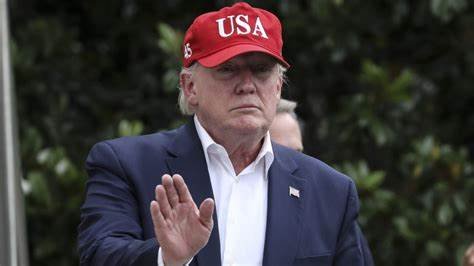In a bold and highly consequential move, former President Donald Trump has renewed his threat to impose a 25% tariff on goods imported from Mexico and Canada. This latest stance has sent shockwaves through North America, potentially upending years of trade agreements and economic relationships. The announcement is more than just a political statement; it reflects Trump’s continuing commitment to a protectionist approach that could dramatically reshape trade dynamics between the U.S., Mexico, and Canada.
Trump’s 25% tariff proposal comes as part of his broader efforts to impose what he perceives as fairer trade conditions for the United States. Throughout his presidency, Trump sought to renegotiate trade deals that he felt were disadvantageous to American industries, focusing on policies that would prioritize U.S. economic interests above global considerations. This new tariff threat targets key sectors, including automotive, electronics, and agricultural industries, all of which have deep supply chains rooted in North America.
The imposition of a 25% tariff could have far-reaching consequences, disrupting not just the flow of goods but also the intricate cross-border supply networks between the U.S., Mexico, and Canada. Any rise in tariffs would likely lead to higher costs for U.S. companies that import materials and components from these countries. As a result, businesses would either absorb the increased costs or, more likely, pass them on to consumers in the form of higher prices.
Economists warn that this could ignite inflationary pressures, particularly in sectors like manufacturing, which depend on affordable imports. Moreover, industries such as agriculture, where trade between these countries is particularly sensitive, could experience severe disruptions as tariffs increase prices for agricultural products such as pork, beef, and grains.
The political calculus behind Trump’s tariff threat is clear. Aimed at appealing to his political base, the move underscores his continued commitment to the “America First” agenda that became a hallmark of his presidency. Protectionism, particularly through tariffs, was a core part of his platform, emphasizing the need to bring more jobs and manufacturing back to the U.S.
However, the threat of a 25% tariff on imports from Mexico and Canada could also be seen as an attempt to force negotiations on trade deals he believes are too lenient on foreign competition. The timing of the threat is noteworthy—Trump may be seeking to position himself as a strong economic leader ahead of future political engagements. This also signals a broader strategy to challenge the global trade order and push for terms more favorable to American industries.
Still, the political consequences of such a move could be significant. A unilateral tariff imposition may strain U.S.-Mexico-Canada relations, potentially triggering a trade war between the three countries. While Trump’s populist policies garnered significant support during his presidency, such aggressive actions risk alienating international allies, complicating diplomacy, and disrupting global markets.
The trade relationship between the U.S., Canada, and Mexico is one of the most important in the world. According to the U.S. Census Bureau, in 2021, the U.S. exported $80 billion worth of goods to Mexico and $30 billion worth of goods to Canada, with both countries being among the U.S.’s largest trading partners. Any disruption in these trade relations would not only harm these countries economically but also result in political fallout.
For Mexico, the proposed tariffs could be devastating, particularly in the automotive and manufacturing sectors, which are heavily reliant on U.S. trade. Mexico is the largest exporter of automobiles to the U.S., and any tariff on these goods could result in increased production costs and potentially higher prices for consumers. Similarly, Canada would face economic consequences, particularly in the energy and agricultural sectors. Canadian farmers, for instance, could see their products becoming less competitive due to tariff-induced price hikes.
Beyond the economic strain, political leaders in both countries would likely view the tariffs as a direct threat to the longstanding relationship that underpins much of North America’s economic stability. Retaliation would be a natural response, and both Mexico and Canada could look for ways to implement their own tariffs on U.S. goods in response, which could escalate into a full-blown trade dispute.
While the immediate focus is on North America, Trump’s tariff threat has global implications. The economic ripples from such an action could be felt across global markets, especially in industries tied to international supply chains. The automotive and electronics sectors, for example, have established production networks that span across continents, with parts manufactured in different countries and assembled in others. A significant tariff could lead to a reshuffling of these networks as companies attempt to mitigate the added cost.
Moreover, such a move could prompt other nations to reassess their trade agreements with the U.S., potentially resulting in a more fractured and unpredictable global trade system. If tariffs were imposed on Canada and Mexico, other countries, particularly in Europe and Asia, might follow suit with their own protectionist measures, leading to trade disruptions worldwide.
While Trump’s stance on tariffs is designed to protect U.S. industries, it risks triggering a series of retaliatory measures that could harm not just North American economies but global growth. As companies brace for the uncertainty of a tariff-heavy world, the possibility of widespread trade conflicts could weigh heavily on global stock markets and investors.
As Trump’s political influence remains potent, especially within the Republican Party, the potential for his return to power means that these trade policies could be revived or strengthened. While the current U.S. administration’s stance on tariffs has been more focused on multilateral trade negotiations, Trump’s protectionist rhetoric remains a significant factor in shaping the future of U.S. trade policy.
It remains to be seen whether Trump will be able to follow through on his 25% tariff threat and how this will influence the dynamics of U.S.-Mexico-Canada trade relations. What is clear, however, is that the global trading system remains in a state of flux, with the possibility of further trade tensions creating uncertainty for businesses and consumers alike.
Stay informed and ahead of the curve with Innovation Times—your go-to source for the latest news, insights, and analysis on global trade, politics, and economics. We provide comprehensive coverage of the stories that matter to you, including breaking news on tariffs, trade policy, and international relations.
🔗 Sign up now at www.innovationtimes to receive exclusive reports, expert opinions, and timely updates that keep you informed on the changing landscape of global business and politics.



